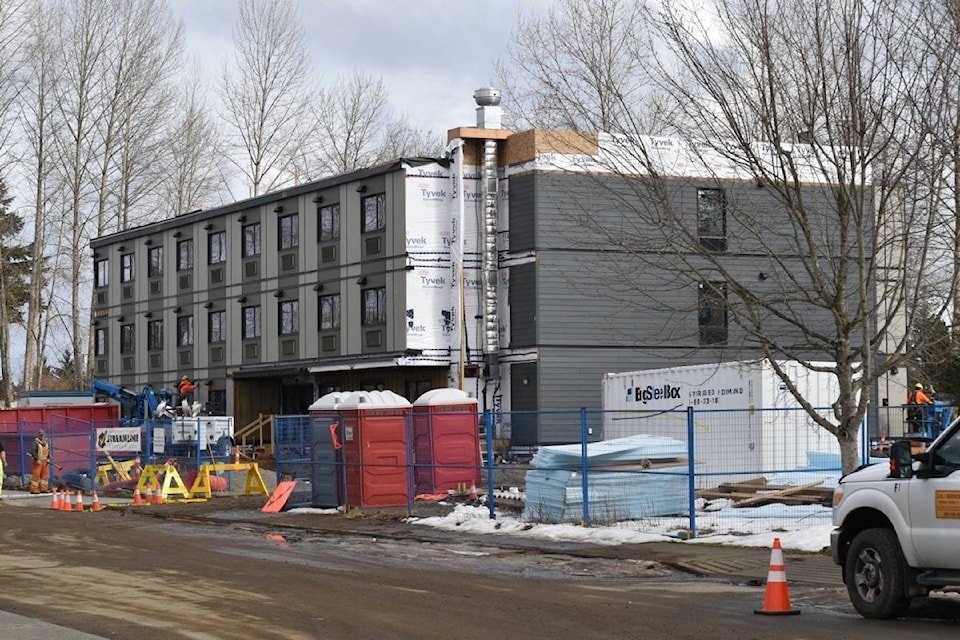A number of initiatives are in the works to help house those who live on the fringes of society in the Comox Valley. The Braidwood affordable rental complex and a supportive housing complex, both in Courtenay, will house individuals who are struggling with, or at risk of homelessness. Habitat for Humanity builds affordable homes for families in need. There are also plans to construct student housing at North Island College.
“But we know this is a ‘drop in the bucket’ of what is actually needed for our community, especially for the missing low- to moderate-income earners,” said Andrea Cupelli, co-ordinator of the Comox Valley Coalition to End Homelessness.
The coalition is a collective of agencies that develop community responses to homelessness. It defines housing affordability as spending no more than 30 per cent of one’s income on rent. According to the BC Non-Profit Housing Association Rental Housing Index, 45 per cent of renters spend more than 30 per cent of their income on housing. A further 20 per cent spend at least half their earnings on rent.
Cupelli said the 24 member agencies are working to address and advocate for a range of affordable housing needs from across the housing continuum, from emergency shelters to low-cost rentals.
“In my six years of outreach in the Comox Valley, the number of calls I receive from working people simply looking for housing has increased five-fold,” said Grant Shilling, an outreach worker with the Dawn to Dawn Action on Homelessness Society. He recently received a call from a woman who earns $19/hour but cannot find an affordable place for herself and her two children.
“This is not unusual,” Shilling said.
In a 2018 Point in Time Count, the coalition surveyed 117 homeless individuals in the Valley. Of these, 58 per cent fell into the category of ‘absolute homeless,’ defined as living in public spaces, emergency shelters or public facilities. The other 42 per cent were ‘hidden homeless,’ those who couch-surf or live in temporary accommodations.
Since the private sector market isn’t going to provide the answers, Courtenay council is looking at creative solutions that rely on senior government funding, Doug Hillian said.
Council is giving a ‘tax holiday’ for those who build rental accommodations near the downtown core. It’s also considering whether the City has land to donate to Habitat for Humanity.
“We want to see if they can do something on a bigger scale,” Hillian said. “If not, we’re looking at co-op housing. It’s really about building, I think at this stage, some multi-family (facilities) where a mom and two kids can live and not have to pay everything they have in rent.”
Courtenay-Alberni MP Gord Johns has spoken about the need for non-market housing, which can include government-subsidized social housing, not-for-profit housing and co-op housing.
“We have been exploring and advocating for co-op rental housing, secondary suites, micro-housing, and the construction of more purpose-built rental buildings for our community,” Cupelli said. “The affordable housing crisis affects us all.”
Even employers are feeling the pinch.
“If we have an employee making a decent amount of money, it doesn’t matter if they can’t find a place (to live),” said Courtenay Mayor Bob Wells. He had an employee at My Tech Guys who was forced to move to Parksville because he couldn’t find anything locally.
“It’s a huge issue, employers who hire people who can’t find a place to live,” Hillian said.
Wells said the accelerated rate of inflation compared to the cost of living, the rate of wage increases, and low vacancy rates is “creating an immense divide” in the community.
“I think we really need to drill into the rental side of things,” he said.
At a municipal level, Shilling said incentives need to be created by reducing development cost charges — and reducing expectations for the number of parking stalls — in order to encourage construction of more rental units.
“I would suggest an incentive for renters who don’t own cars,” he said.
Shilling also feels the “Airbnb situation” needs to be addressed, by way of incentives that favour long-term rentals over Airbnb-style vacation rentals.
“Over 300 units in the Comox Valley that could potentially belong to the long-term rental market are now lost,” Shilling said. “It has been demonstrated that offering long-term, local housing, economically, is of greater benefit to both the landlord and the community. It is also a moral imperative.”
As a politician, Wells said there is a “delicate balance” of acting on behalf of all constituents, while dealing with directives from senior governments. As an example, municipalities are legislated to account for climate change when making decisions.
“On the one hand, there’s been a free-for-all for a long period of time, so the costs of some of these things (such as landfill closures) were never captured originally…They have to be paid now,” Wells said. “We can’t do it ourselves, but we can work together with the homelessness coalition and others to help make real change.”
